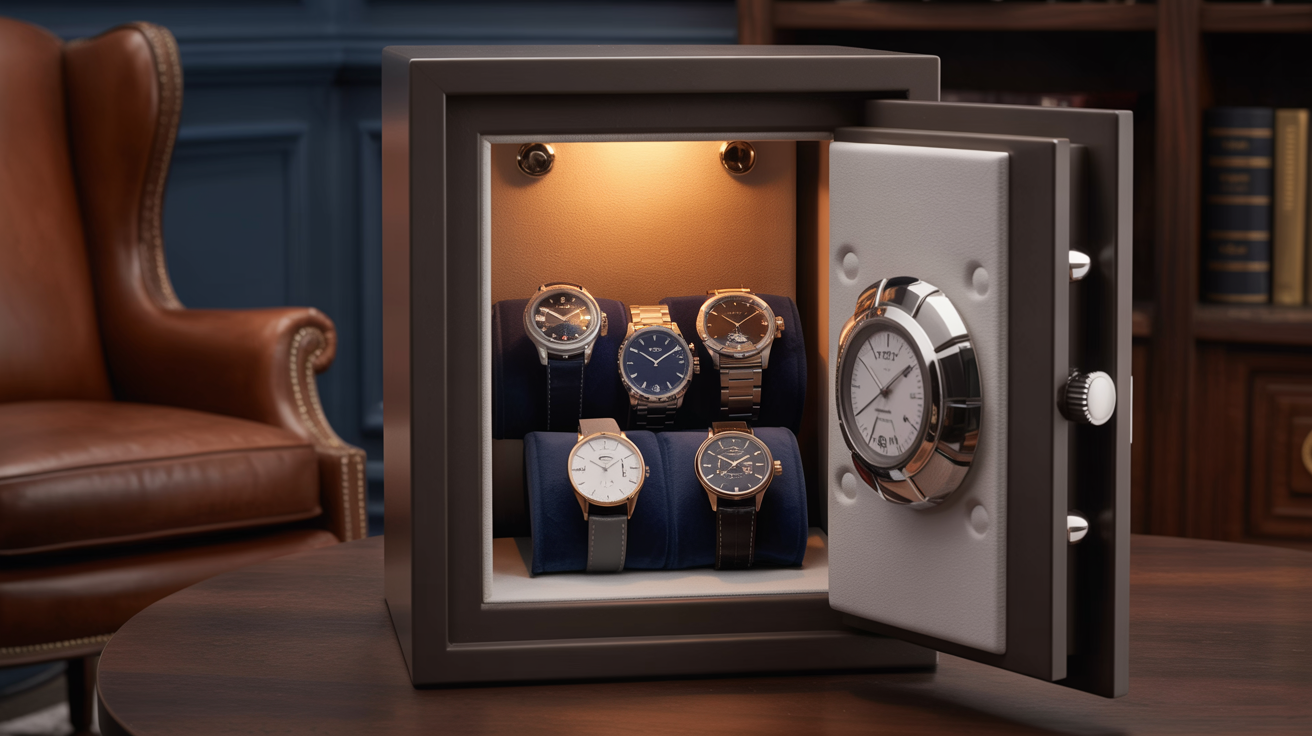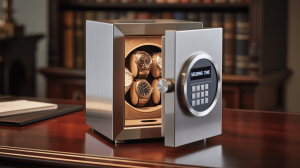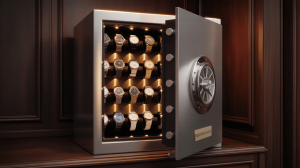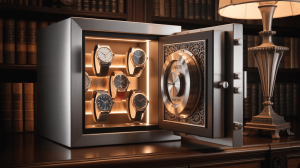Small Watch Safe Essentials: Protect Your Watches Effortlessly. But here’s the kicker… Keeping your timepieces secure doesn’t require a bulky vault—just the right compact safe designed for effortless protection.
1. Key Security Features
A small watch safe must start with a robust exterior. Solid steel construction with a powder‑coat finish resists prying and corrosion, while precise welds eliminate weak points. The lock mechanism—whether an electronic keypad, mechanical key, or biometric scanner—needs to combine speed of access with tamper resistance. Inside, a scratch‑free lining of high‑density foam or plush velvet cradles each watch, preventing dings and abrasion. Discreet, concealed anchor points allow you to bolt the safe firmly to a shelf or desk, adding another layer of theft deterrence without altering the safe’s slim profile.
| Feature | Benefit | Notes |
|---|---|---|
| Steel Body | Resists prying and drilling | High physical protection |
| Lock Mechanism | Keypad, key, or biometric | Tailor access preferences |
| Interior Lining | Foam or velvet | Prevents scratches |
| Anchor Points | Floor or wall mounting | Adds theft deterrence |
2. Ideal Dimensions for Small Safes
Choosing the right size means balancing capacity and concealment. Measure your intended space—whether it’s a nightstand drawer, closet shelf, or hidden cabinet—accounting for the full external dimensions including hinges and handle clearance. Inside, factor in watch height on pillows (typically 1.5–2 inches above the base) and allow extra depth for thicker dive or pilot watches. Don’t overlook extra slots for spare straps, watch tools, or warranty cards. A safe that fits snugly without wasted space offers optimal security and stealth, blending into your furniture rather than standing out.
3. Locking Mechanism Options
Electronic keypads deliver rapid code entry and can store multiple user profiles, but rely on battery power—choose a model with a low‑battery alert. Mechanical key locks are impervious to power loss, though keys must be kept secure. Biometric scanners provide one‑touch fingerprint access, ideal for hands‑free retrieval but often costlier and require occasional re‑enrollment of prints. Dual‑lock systems combine keypad plus key or biometric plus key, ensuring that a single failure won’t lock you out. Evaluate your priority—speed, reliability, or redundancy—and select locks accordingly.
4. Interior Organization Essentials
Inside your safe, modular organization keeps watches pristine and ready to wear. Removable watch pillows conform to case shapes, cradling each piece snugly. Foam inserts with pre‑cut cavities can be reconfigured for different watch sizes or additional items like cufflinks. Dedicated strap slots or small zip‑pockets secure extra bands without tangling. A hidden compartment beneath the main tray can store cleaning cloths, screwdrivers, or warranty cards out of sight. Effective organization prevents watches from shifting during opening and keeps your collection curated at a glance.
| Organizer Type | Purpose | Advantage |
|---|---|---|
| Watch Pillows | Cradle each watch | Prevents movement |
| Foam Inserts | Customizable compartments | Fits various watch sizes |
| Strap Slots | Stores extra bands | Keeps accessories organized |
| Tool Compartments | Holds cleaning tools | Ready‑to‑use convenience |
5. Fire and Heat Resistance
Even small safes can offer meaningful fire protection. Look for models with a 30‑minute UL 72 fire rating, capable of withstanding up to 1,400°F. Insulated walls crafted from gypsum or ceramic composites block heat transfer, keeping internal temperatures below 350°F—safe for watch lubricants and springs. Expandable intumescent gaskets seal door seams when exposed to heat, locking out smoke and preventing internal damage. While compact safes won’t match full‑size vault fire ratings, 30 minutes provides crucial time for fire crews to extinguish most household blazes.
6. Water and Dust Protection
In addition to fire, small safes should guard against moisture and particulate intrusion. A rubberized door seal with a minimum IP54 rating blocks dust and light splashes, keeping interiors dry and clean. Corrosion‑resistant coatings on steel surfaces and stainless steel hardware further protect against humidity‑related rust. For coastal or humid environments, consider adding silica gel packs or integrated desiccant chambers to maintain sub‑50% relative humidity and preserve delicate watch components and leather straps.
7. Discreet Placement Strategies
The most secure safe is one that remains unnoticed. Under‑bed mounting uses low profiles to hide safes within frame cavities. Closet shelves can conceal safes behind clothing, while hideaway cabinets tuck safes behind décor panels or inside hollow bookcases. Some furniture manufacturers offer furniture‑integrated safes that look like ordinary nightstands or desks. Regardless of method, ensure installation still allows quick access when needed. Creative placement not only hides your safe but also reduces temptation for would‑be thieves.
| Placement Method | Visibility | Security Boost |
|---|---|---|
| Under‑Bed Install | Very low | Hidden from plain sight |
| Closet Shelf | Low | Out of casual reach |
| Behind Décor | Concealed | Blends with surroundings |
| Furniture Insert | Fully hidden | Maximum stealth |
8. Power Options for Electronic Safes
Electronic and biometric safes depend on power. Standard AA batteries provide months of life; select safes with a low‑battery warning to avoid lockouts. Rechargeable battery packs reduce long‑term cost but require periodic charging—USB‑powered models can draw from laptop or phone adapters. Some high‑end safes support solar trickle charging via small panels mounted discreetly on top surfaces. Always keep a manual override key in a secure but separate location for emergency access.
9. Maintenance and Upkeep
Routine care extends safe lifespan. Wipe the exterior monthly with a soft cloth and mild detergent to remove dust and oils. Quarterly, test the lock under normal and backup methods, ensuring combinations and biometric scans register correctly. Replace batteries every six to twelve months—or per manufacturer guidelines—to maintain electronic locks and internal lighting. Annually inspect interior linings for foam compression or wear, and replace inserts to guarantee cushioning. A well‑maintained safe remains as reliable as on day one.
10. Emergency Access Solutions
Lockouts can happen—lost codes, worn batteries, or fingerprint misreads. Keep a backup mechanical key hidden in a secure alternate location, such as a home office safe or trusted relative’s house. Some safes feature an override code entered via a hidden keypad. Manufacturer support lines can often remotely verify purchase and provide one‑time master codes. Ensure you understand emergency procedures before storing valuables, so you’re never locked out when you need access most.
| Access Method | Reliability | Ease of Use |
|---|---|---|
| Backup Key | Very high | Manual retrieval |
| Override Code | High | Quick code entry |
| Hidden Key Compartment | Moderate | Requires knowledge of location |
| Manufacturer Support | Variable | Dependent on response time |
11. Style and Aesthetic Options
Small safes no longer need to look industrial. Matte black, brushed stainless steel, or leather‑wrapped exteriors complement modern décor. Interiors offer wood veneer panels or carbon‑fiber accents for a luxury feel. Some brands provide custom color matching to cabinetry or custom engraving. When choosing a safe, consider finishes that enhance your room’s style while delivering uncompromised security.
12. Smart Monitoring Features
Bring home automation to your safe with integrated Bluetooth or Wi‑Fi. Receive real‑time tamper alerts on your smartphone, view digital audit logs of each access attempt, and remotely lock or unlock your safe in seconds. These features add peace of mind when you’re away from home, knowing you’ll be notified instantly if anyone tries unauthorized entry.
| Smart Feature | Functionality | Benefit |
|---|---|---|
| Bluetooth Alerts | Sends tamper warnings | Immediate awareness |
| Audit Logs | Records access attempts | Track user entry |
| Remote Lock/Unlock | Mobile control | Convenience |
| Tamper Sensors | Detect unauthorized force | Enhanced security |
13. Budgeting for Small Safes
Entry‑level small safes start around $50–$100, offering basic steel shells and key locks. Mid‑range models at $100–$200 add fire resistance, electronic keypads, and improved interiors. Premium safes over $200 boast biometric locks, smart features, luxury finishes, and higher fire ratings. Allocate budget based on must‑have features: security certifications first, then aesthetic and smart extras.
14. Installation and Anchoring Basics
Even the best safe fails if it can be carried off. Use provided brackets and heavy‑duty anchors into studs or concrete. Conceal mounting bolts under interior lining or trim panels to maintain aesthetics. Verify stability by attempting gentle prying or lifting—proper anchoring transforms your compact safe into a nearly immovable fortress.
| Installation Step | Tool Needed | Security Impact |
|---|---|---|
| Drill Anchors | Electric drill | Secures base to surface |
| Mount Brackets | Screwdriver | Holds safe firmly |
| Conceal Bolts | Decorative caps | Maintains aesthetics |
15. Conclusion: Effortless Watch Protection
Small watch safes deliver high security in a compact form. With solid construction, thoughtful interiors, and optional smart features, safeguarding your timepieces has never been easier. Ready for the good part? Choose the essentials that fit your style and space to protect your collection effortlessly.
FAQ
Q1: How deep should a small watch safe be?
Aim for 6–8 inches depth to fit most watches on pillows comfortably.
Q2: Are battery‑powered locks reliable?
Yes—models with low‑battery alerts and manual overrides ensure dependable access.
Q3: Can any safe support smart monitoring?
Only safes with built‑in electronics and connectivity options support remote alerts.
Q4: How often replace foam inserts?
Replace every 1–2 years or when compression marks appear to maintain cushioning.
Q5: Is professional installation required?
DIY anchoring to studs is doable; just ensure strong fasteners and follow manufacturer guidelines.







